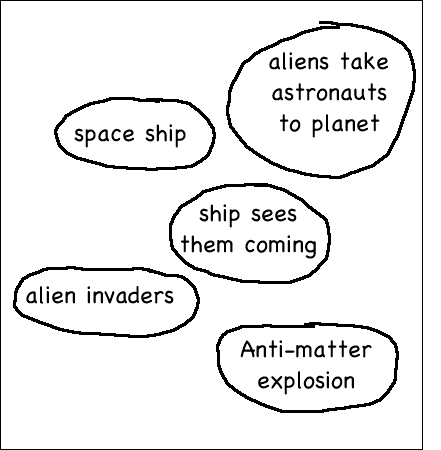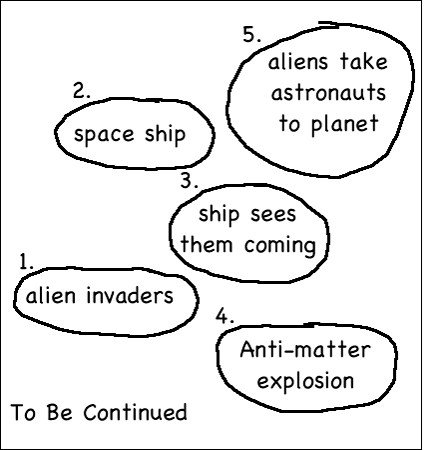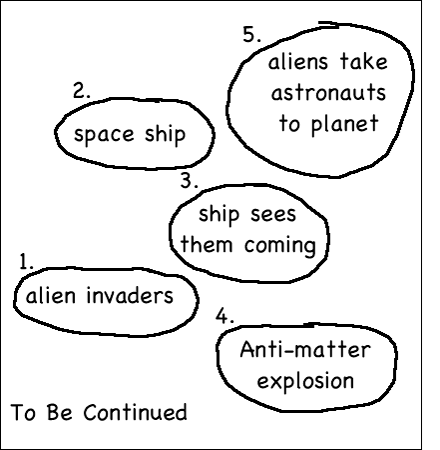Comprehension and ![]()
How to Write Natural Language Stories
1. Tell your student that you are going to be her 'secretary.' Write down something she says.
- Print in upper and lower case letters, not all-capitals.
- Print in a size your student likes. Larger print is more memorable.
- You can use a broad-tip pen (not a fine-point pen), or a dark-colored marker. Variety is good.
- You can print on lined or unlined paper--just be sure that the size of your printing is comfortably large.
- You can use a computer. Start with a large font and a simple style.
![]()
2. T-a-lk a-s y-ou wr-i-te, when you can.
This is like ‘thinking out loud’ as you write.
L-e-t y-ou-r s-t-u-d-e-n-t o-b-s-er-ve th-e p-r-o-c-e-ss
o-f s-t-r-e-tch-ing th-e w-or-d-s y-o-u s-a-y
a-s y-ou w-r-i-t-e th-e s-ou-n-d-s.
For beginners:
- Use a new line for each new sentence.
- Write simply. Break a long sentence into two shorter ones.
- Repeat some of the words from one sentence in the next one, if possible.
- Keep it short at first.
Your student may not speak shortly, simply, or repetitively.
(Or your student may not say much at all.)
Pick out, or make up, something simple from what they have said.
Ask “Shall I write ‘--------’?” to get approval for your suggestions.![]()
Here are some ideas to start you off:
- When your student makes a comment, or tells you about something that has happened, be ready to write it: “I hate liver!”
- Say to your student, ‘Tell me about your picture’. Then write a sentence or more based on your student’s own words.
- Think of a topic and talk about it with your student. If you want more material, use questions to draw out more ideas from your student.
- Ask your student to retell a familiar joke or story as you write it down.
- Ask your student to tell a story patterned after a favorite book, such as Goldilocks and the Three Bears; or any your student likes. For variety, she can change the characters, or the setting, or the events.
![]()
Example
Mom (the Secretary) Captures a Natural Language Story:
Just about anything your student says, can get you started.
Keep a clipboard of paper handy.
“Yuk, I hate liver.”
[Secretary writes and says] “ ‘I h-a-te l-i-v-er.’
Sometimes you can lead the discussion so that you get repetitive sentences.
[Secretary reads back, pointing to words] ‘I hate liver.’ What else do you hate?”
“A bath.”
[writes and says ] “ ‘I h-a-te b-a-th t-i-me.’ “
[Secretary reads whole story so far, pointing to each word] “ ‘ I hate liver. I hate bath time.’ What else?”
“The news.”
“Shall I put ‘I hate TV news?’ “
“Okay.”
[writes and says] “ ‘I h-a-te T-V n-ew-s.’ “
[Secretary re-reads whole story so far, pointing] “ ‘ I hate liver. I hate bath time. I hate TV news.’ How’s that?”
“Good.”
“Well, what do you like?”
“Um, chicken.”
“ ‘I like chicken, but I hate liver!’ How’s that?”
“Yeah.”
[Secretary writes]
“What else do you like?”
“Candy.”
“Shall I write, ‘I like candy, but I hate liver?’ “
“Yeah.”
[Secretary writes; then reads whole story, pointing.]
“The end?”
“Yeah.”
[Secretary writes ] “ ‘ Th-e E-n-d.’ Good story. Let’s see how it sounds. [Secretary reads whole story again, pointing to words]
“Let’s think of a name for this story. Let’s see . . . we have ‘I hate liver, I hate bath time . . . [re-reads the story] What can we call it?”
“Liver.”
“And it’s about some other stuff, too, isn’t it? Maybe ‘Liver and Stuff?’
“No, ‘Liver Yuk.’ “
“Good name. [writes at the top of the page] ‘Liver Yuk, by Evan Carter.’ Let’s see how that sounds . . . “ [re-reads the story with title]
[You get the idea.]
![]()
Example
Dad (the Secretary) Captures a Wild Natural Language Story:
Children do not always express their whole message in words.
“Jesse went up on the ramp an’ he [gestures] an’ he--right into me! [crashing noise.]
“Wow, that’s pretty amazing! Let me write that down.”
[Secretary writes as son continues to talk.] “Just a second: [reading back and pointing to each word] ‘Jesse went up on the ramp,’ right?”
“Uh-huh. An’ he [gestures, crashing noises.]”
“Shall I write, ‘Jesse . . . flipped up? Flew up?”
“Uh-huh.”
“How about ‘Jesse flew up.’
“Yeah . . .
[Secretary writes.]
“ . . . up [gestures] an’ he bumped into me!’
[writing] “’J-e-ss-e f-l-ew u-p.’ He flew way up?”
“Way up!”
[writing] “ ‘J-e-ss-e f-l-ew w-a-y u-p.
J-e-ss-e b-u-m-p-e-d i-n-t-o m-e.’
Did he knock you down?”
“No.”
“Shall I write, ‘He didn’t knock me down?’ “
“No, don’t put that . . . Just put . . . nothing.”
“The end?”
“Yeah, The End.”
[Secretary writes and says] ‘Th-e E-n-d.’ Great!”
[Secretary re-reads the whole story.] “What can we call this story?”
[silence]
“How about . . . ‘Crash?’ . . . ‘The Flying Jesse?’
“Yeah, ‘The Flying Jesse.’”
[Secretary writes at the top] ‘The Flying Jesse, by Matt Baer’
Let’s see how that sounds. [Secretary re-reads story from the top]![]()
Capturing Stories from More Advanced Students
More advanced students have more elaborate things to tell.
But whether they are recounting a movie, or making up a story, their ideas may not come to them in a logical order.
Here is a way to structure more difficult stories.
1. Brainstorm ideas in any order.
You can help by asking a question now and then.
2. Jot down each idea in-no-particular-place on the page.
Circle it.

3. Help the student decide which idea he wants to use first . . . next . . . after that . . .
Number them.
Write the story by turning the notes into sentences.
![]()
Example
[Secretary reads] " ‘Number 1, Alien invaders.‘ What do you want to say to begin your story?" . . .
[Silence]
"How about . . . [pause, giving student some think-time] . . . ‘The alien invaders zoomed toward the space station?‘ . . . [think-time] . . . ‘Once there were some alien invaders?’ " . . .
"Here come the alien invaders."
[Secretary says and writes] " ‘H-ere c-ome th-e a-li-en in-va-ders.’ [Pointing and repeating] ‘Here come the alien invaders.’
Now number 2, ‘Space ship.’

"It’s on a mission to Mars."
[Secretary says and writes] " ‘Th-e sp-ace sh-ip i-s o-n a mis-sion t-o M-ars.’ [Points, repeating] ‘The space ship is on a mission to Mars.’ "
Now number 3, ‘Ship sees them coming.’ "
"The ship sees them coming."
[Secretary says and writes] " ‘ Th-e sh-ip s-ees ‘ . . . Do you want to say ‘the ship sees them coming’ . . . ‘the ship sees the aliens coming?"
"The aliens coming."
[Secretary says and writes; re-reads the sentence] "Okay; let’s see what we have so far." [Re-reads the whole story]
If the story is rambling on and on . . .
You can always suggest ‘To Be Continued.’
![]()
Short Cut Through the Treehouse ~ The Whole Treehouse
More on this topic: How to Use Natural Language Stories



